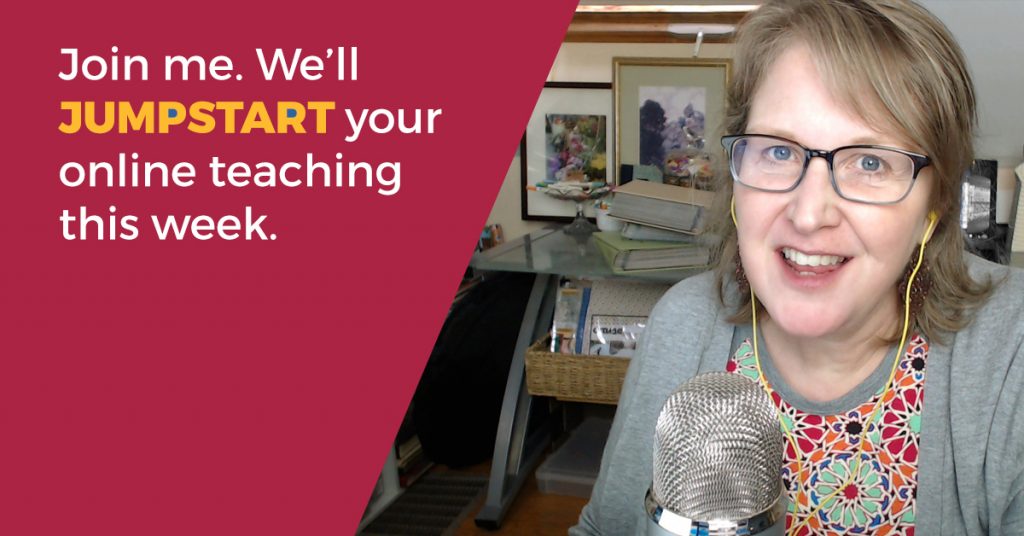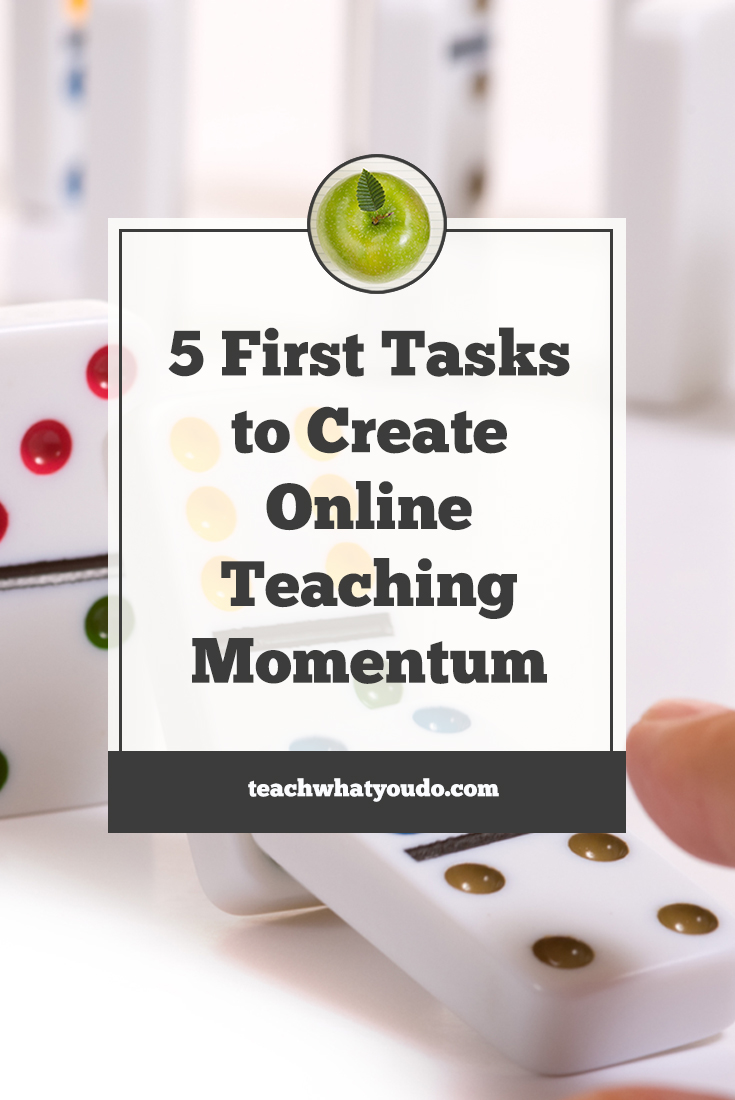 Abe Lincoln said, “If I had six hours to chop down a tree, I'd spend the first four hours sharpening the axe.”
Abe Lincoln said, “If I had six hours to chop down a tree, I'd spend the first four hours sharpening the axe.”
He knew that preparation matters, that laying the right groundwork is crucial to successful outcomes.
Here are the five first groundwork-laying steps for ensuring you have momentum, and a profitable direction for your online course.
1. Make sure you have a refined course offer that meets four tests
An idea for a course topic is not the same as a fully-planned and structured offer. An offer is your topic shaped. This shaping is based upon your audience needs, your talents, your complete business portfolio, and your market.
The successful ecourse will address a pressing need, PROBLEM, or aspiration your audience faces. It will make a PROMISE for its solution, and then deliver the PATH to student transformation.
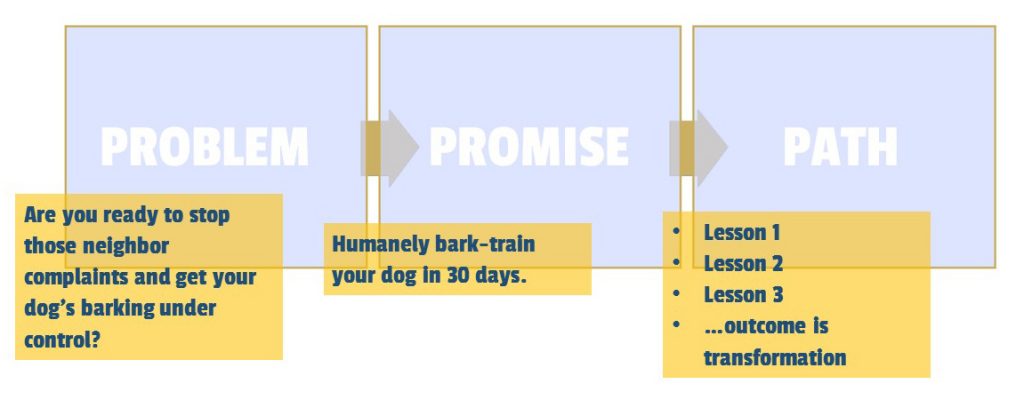
The work of validating and refining a course topic for this model includes four steps:
- Evaluate your audience needs,
- Evaluate your own personal talents,
- Refine for your business portfolio, and
- Position within the greater market.
Click here for step-by-step details on these for steps to defining your course offer.
2. Outline your course content
With the first step completed, NOW is the time to outline your course content, with this content dictated by
- the outcome your audience wants
- an emphasis and reliance on your special talents
- the positioning of your course in the market
- the place this course occupies in your business portfolio (and sales funnel)
Start with the things you need to teach to get your students to their outcome and work backward to create a detailed course outline:
- brainstorm all the pieces you need to teach
- group pieces together logically and for flow to create chunks of teaching that go together
- winnow and organize those chunks in to a series of lessons or modules
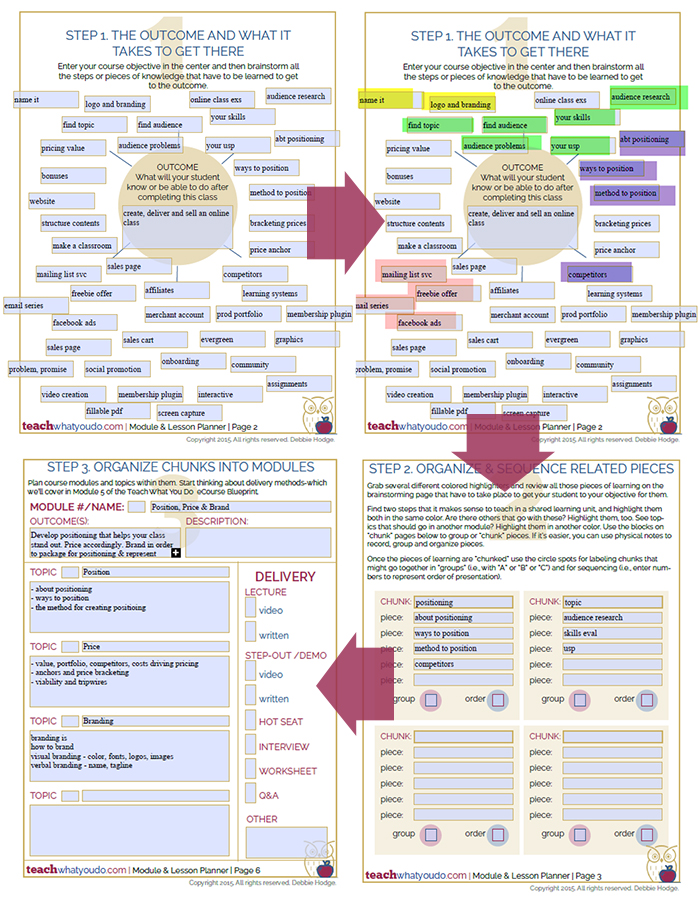
3. Create clear and simple course branding
Step 1. Name your course to clearly convey the successful outcome your students will achieve.
Step 2. Clarify your business personality and how you want your students to feel as they execute with the lessons in your course. Start by answering these questions:
- How do you want your audience to feel when they are engaging with you and your content and products and website?
- What is your promise with this course?
- How do you set yourself apart from your competitors?
- What effect do you want your work to have on your audience?
Part 3. Use three tools–color, typograpy, and image–to make a simple class logo with your course name to convey subject, outcome, and personality.
Here are a two of the six simple logos we've developed for our training templates. Notice how the colors, typefaces, imagery and course names all combine to represent the courses clearly and simply.

4. Write A Course Pitch
As you create your course, you'll also be building and nurturing an audience of potential students for your course.
When you are clear on what your prospects need to understand, be aware of, and even believe in order to want and need your course, you are better able to provide free lessons and resources that move them forward.
To that end, I recommend writing a short course pitch now, in the early days, right after you've gone through the work of refining and defining your course topic. It will clarify your work and provide a reminder and guide for where you're headed. (And it will be a great kickstart to the work of writing a sales page later.)
Your pitch should include:
- Your course name.
- Your course promise.
- A description of your customers’ relevant problem along with agitation of that problem.
- Your solution to the problem (=your course).
- Short list of key features TIED TO THE KEY BENEFITS of your course.
- What students will create/accomplish.
- Call to action.
Here's an example:
COURSE NAME: Jumpstart Your eCourse
PROMISE: CREATE ESSENTIAL FIRST COPY, BRANDING, LIST BUILDING FUNNEL, AND WORK PLAN TO MOVE YOUR ONLINE COURSE FORWARD
Are you ready to turn your digital product idea into an honest-to-goodness online course offering?
PROBLEM: Several crucial first tasks keep the majority of course builders from ever moving out of the dream-up stage. These tasks include: market positioning, course design, branding, establishing and growing an email list, and writing a course pitch.
SOLUTION: Jumpstart Your eCourse is step-by-step guide to this work.
FEATURES TIED TO BENEFITS:
It provides 7 short video lessons interwoven with a rich workbook that has you brainstorming, researching, making decisions, and moving forward quickly.
Templates and tech tutorials enable you to make your own logo, classroom badges, social media images, and an infographic-styled lead magnet–all within the PowerPoint slidemaking software.
Email swipe files and step-by-step tech tutorials (with ConvertKit, ActiveCampaign, and Mailchimp) get you delivering list-building freebies and connecting with prospects immediately.
Are you ready to refine and define your course offering?
WHAT STUDENTS WILL CREATE:
With Jumpstart Your eCourse you will create:
- market and portfolio positioning for your course,
- branding and graphics for social media, marketing, and classroom,
- an infographic-style list-building freebie
- opt-in and email funnel with freebie delivery and welcome series
CALL TO ACTION: Get out of the dream-up phase and give your course true momentum with solid market positioning, branding, and list-building funnel.
5. Start Building an Engaged Email List
You best ecourse selling tool will be an email list of interested prospects.
Social media is definitely important and there are a variety of ways to use it to connect with, nurture, and build interest in your audience. Facebook groups, live streaming, Instagram, Snapchat, and Pinterest all enable engagement and can further your reach.
But you cannot market to people on social media the way you can with email. You need to convert as many of those social media contacts as possible into subscribers to your email list.
The way you’ll get folks onto your email list is by offering an irresistible freebie, a lead magnet, an ethical bribe.
Start by creating something to offer for free that can be quickly and immediately consumed by your prospects for quick wins.
Make sure this “freebie” precedes a need for your course. If your course is on bike repair, a good freebie is the 5 tools one needs to do their own bike repairs—and maybe even how-to for a quick bike wellness check. This kind of resource gets people moving forward and seeing the potential that developing this skill gives them.
There are, for sure, many other freebie formats, including quizzes and assessments, contests, templates, swipe files, cheatsheets, challenges, eBooks and mini-courses. But I strongly recommend you start with a “5-things” or “5-ways” or “5-tools” freebie that you know will be super useful and precede a need for your course. It's quick to create and both appealing and quick to consume for your prospects.
Here's a look at three of six “5-things” templates my students can use in Jumpstart Your eCourse to create their first lead magnet.
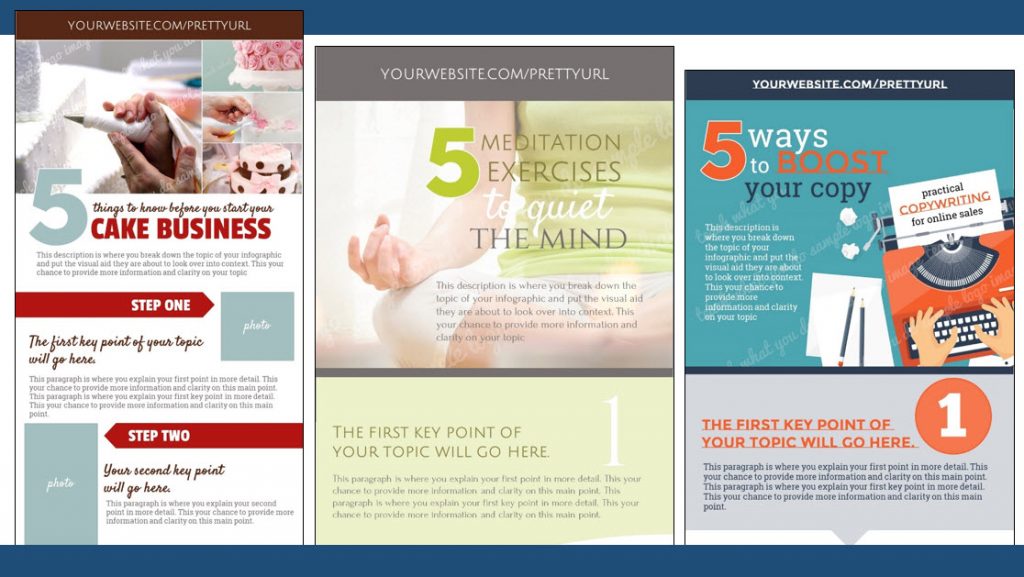
And then you've got to set that freebie up to be requested by prospects and successfully delivered to them. This is a mechanical task with several moving pieces and steps that, unfortunately, holds many would-be course builders up.
Figuring this out and executing on this step is key to building an email list of good prospects as you build your teaching business.
Here are the steps to this work:
- Make your freebie and render it in .jpg and .pdf formats.
- Upload your freebie to your server or a place like Amazon S3 file storage. Get the URL for your freebie file. [Optional] Add a page to your website upon which you’ll show the freebie graphic (.jpg) and link to the freebie pdf download URL.
- Make images you can use to promote your freebie on your website and in social media.
- Write an email for delivering your freebie. It will include a link to the webpage where the freebie sits OR the url to the pdf file.
- [Optional] If you haven’t already developed an email “welcome” series, write this now. People will get it a day or two after they get the freebie.
- Create an opt-in form or dedicated landing page where people can sign up for the freebie.
- Set up email automation to:
a. “Tag” the new contact for requesting the freebie
b. Trigger the email delivering the freebie, and
c. “Tag” the contact for a welcome series IF they are new (and then trigger that email series at the right time). - Get the news out about your freebie’s availability to prospects.
So that's it. 5 crucial first steps.
The step-by-step how-to (along with templates and tech tutorials) for these steps are detailed in Jumpstart Your eCourse.
JUMPSTART YOUR eCourse
Jumpstart Your eCourse is a compact, actionable series of video lessons interwoven with worksheets, graphics templates and tech tutorials that step you through the essential first work of creating a successful online teaching business.
With Jumpstart Your eCourse and 20 to 30 hours of work, you will create:
- A positioned course offering that builds on your talents and identified audience needs.
- Your course description, written to hook interested prospects.
- A branded course logo and promotional images.
- An irresistible infographic-styled “5 Things” or “5 Ways” or “5 Steps” freebie to offer for building your email list.
- Your email automation for offering and delivering your freebie as well as a 3-part welcome series to your prospects.
- A detailed plan for the work to do to complete, launch and sell your course.

